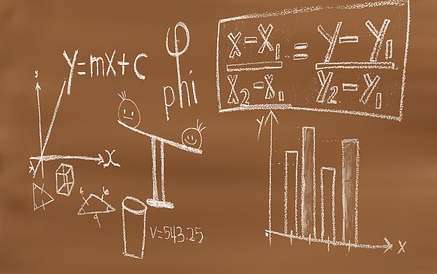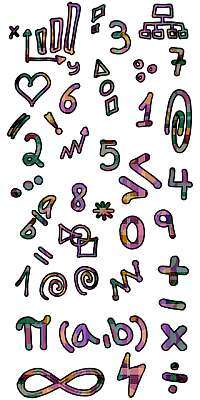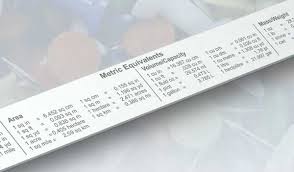关于这个运算顺序计算器
使用这个计算器来扩展和简化你提供的任何有效的数字或符号表达式。一个有效的数字表达式是像(1/3+1/4)(1/5+1/7),而一个有效的符号表达式是像(x+3/4)^2-(x-1/2)^3。
当你的表达式已经添加到相应的框中时,你所需要做的就是点击 "计算 "按钮来获得所有显示的步骤。一些简单的表达式只需要几个步骤就可以简化,但是根据原始表达式的复杂程度,要完全简化它可能会非常费力。
我们的想法是要遵循
PEMDAS步骤
,而黄金法则是永远从内部括号开始,从内向外扩展,遵循操作规范的顺序。

如何用分数进行运算排序?
这是PEMDAS有趣的地方之一:对于不同的操作数,程序完全没有变化。事实上,PEMDAS并不关心你有什么类型的操作数,它只关心操作的顺序。
你的操作数可以是数字或分数,甚至是平方根,它不会改变位PEMDAS遵循的顺序。
计算的正确运算顺序是什么?
你需要遵循这个操作顺序。
-
第1步:P=括号
-
第2步:E = 指数
-
第3步:M = 乘法
-
第4步:D = 分数
-
第5步:A=加法
-
第6步:S = 减法 乘法
请注意,这并不是说你要在所有的加法之前做,比如说ALl乘法。事实上,请考虑下面的表达式。
\[ 3\times (3+5)\]
你会先做哪个运算?对运算顺序规则的误解是说 "先乘法后加法"。在这种情况下,我们需要先关注括号内的加法,而我们需要先简化括号内的加法。所以我们要做的是
\[ 3\times (3+5) = 3\times 8 = 24 \]
所以在这种情况下,我们不得不先做加法,因为为了尊重PEMDAS标准,我们需要先处理小括号。
通常情况下,一个写得好的表达式不会有任何需要用PEMDAS解决的歧义,而且通常情况下,它将包含括号,明确指出哪些操作优先进行。
通常情况下,我们需要使用运算顺序规则来解开一个潜在的歧义,这个歧义没有用括号来处理。
使用正确的操作顺序有多重要?
它是至关重要的!这一点不能被低估。如果没有一套明确的规则来解决潜在的歧义,我们就有可能从同一个表达式开始,得出不同的答案。
你可能不会过多地考虑PEMDAS和操作顺序,但这是因为你大多已经将其内化,而且通常表达式可能带有适当的括号,可以消除歧义。

例子。操作顺序的例子
简化以下内容。\(\displaystyle \frac{1}{4}x + \left( \frac{5}{4}x - \frac{5}{6}x\right) \)<
解决方案:
我们需要简化以下表达式。\(\displaystyle \frac{1}{4}x + \left( \frac{5}{4}x - \frac{5}{6}x\right)\)。
得到以下计算结果。
\( \displaystyle \frac{1}{4}x+\frac{5}{4}x-\frac{5}{6}x\)
Grouping the terms with \(x\)
\( = \,\,\)
\(\displaystyle \frac{1}{4}x+\left(\frac{5}{4}-\frac{5}{6}\right)x\)
Simplifying the terms that were grouped with \(x\)
\( = \,\,\)
\(\displaystyle \frac{1}{4}x+\left(\frac{5}{12}x\right)\)
Removing unecessary parentheses
\( = \,\,\)
\(\displaystyle \frac{1}{4}x+\frac{5}{12}x\)
Putting together the terms with \(x\)
\( = \,\,\)
\(\displaystyle \left(\frac{1}{4}+\frac{5}{12}\right)x\)
Simplifying those terms that were grouped with \(x\)
\( = \,\,\)
\(\displaystyle \frac{2}{3}x\)
这就结束了简化的过程。
例子。更多操作顺序的例子
计算下面的表达式,将其简化。\(\displaystyle \frac{2}{7}\left(\frac{2}{3}x + \frac{5}{4}\right) - \frac{5}{6}x\)<
解决方案:
我们需要简化以下表达式。\(\displaystyle \frac{2}{7}\left(\frac{2}{3}x + \frac{5}{4}\right) - \frac{5}{6}x\)。
得到以下计算结果。
\( \displaystyle \frac{2}{7}\left(\frac{2}{3}x+\frac{5}{4}\right)-\frac{5}{6}x\)
Using the distributive property for the terms inside of the parentheses
\( = \,\,\)
\(\displaystyle \frac{2}{7}\cdot\frac{2}{3}x+\frac{5}{4}\cdot\frac{2}{7}-\frac{5}{6}x\)
We can multiply the terms in the top and bottom: \(\displaystyle\frac{ 2}{ 7} \times \frac{ 2}{ 3}= \frac{ 2 \times 2}{ 7 \times 3} \)
\( = \,\,\)
\(\displaystyle \frac{2\cdot 2}{7\cdot 3}x+\frac{5}{4}\cdot\frac{2}{7}-\frac{5}{6}x\)
Computing the multiplication of terms in the numerator and denominator, we get: \( 2 \times 2 = 4 \) and \( 7 \times 3 = 21\)
\( = \,\,\)
\(\displaystyle \frac{4}{21}x+\frac{5}{4}\cdot\frac{2}{7}-\frac{5}{6}x\)
We multiply all the numerators and all the denominators together, and we get \(\displaystyle\frac{ 5}{ 4} \times \frac{ 2}{ 7}= \frac{ 5 \times 2}{ 4 \times 7} \)
\( = \,\,\)
\(\displaystyle \frac{4}{21}x+\frac{\left(5\times2\right)}{4\cdot 7}-\frac{5}{6}x\)
The term \(\displaystyle 2\) can be factored out for further reduction in the numerator and denominator from \(\displaystyle \frac{ 5 \times 2}{ 4 \times 7}\)
\( = \,\,\)
\(\displaystyle \frac{4}{21}x+\frac{5}{2\cdot 7}-\frac{5}{6}x\)
After simplifying the common factors from the numerator and denominator
\( = \,\,\)
\(\displaystyle \frac{4}{21}x+\frac{5}{14}-\frac{5}{6}x\)
Putting together the terms with \(x\)
\( = \,\,\)
\(\displaystyle \left(\frac{4}{21}-\frac{5}{6}\right)x+\frac{5}{14}\)
Putting together the fractions and simplifying those terms that were grouped with \(x\)
\( = \,\,\)
\(\displaystyle -\frac{9}{14}x+\frac{5}{14}\)
这就结束了简化的过程。
例子。更多pemdas实例
计算\( \displaystyle \left(\frac{2}{3} \times \frac{6}{5} \right)^2 + \frac{3}{5} \)。
解决方案:
我们需要简化以下表达式。\(\displaystyle \left(\frac{2}{3}\cdot\frac{6}{5}\right)^2+\frac{3}{5}\)。
得到以下计算结果。
\( \displaystyle \left(\frac{2}{3}\cdot\frac{6}{5}\right)^2+\frac{3}{5}\)
applying the exponent outside the parentheses to all the terms inside
\( = \,\,\)
\(\displaystyle \left(\frac{2}{3}\right)^2\cdot \left(\frac{6}{5}\right)^2+\frac{3}{5}\)
using the law of exponents to \(\left(\frac{2}{3}\right)^2\)
\( = \,\,\)
\(\displaystyle \frac{4}{9}\cdot\left(\frac{6}{5}\right)^2+\frac{3}{5}\)
expanding the expression \(\left(\frac{6}{5}\right)^2\) leads directly to \(\frac{36}{25}\)
\( = \,\,\)
\(\displaystyle \frac{4}{9}\cdot\frac{36}{25}+\frac{3}{5}\)
Multiplying all the numerators and all the denominators: \(\displaystyle\frac{ 4}{ 9} \times \frac{ 36}{ 25}= \frac{ 4 \times 36}{ 9 \times 25} \)
\( = \,\,\)
\(\displaystyle \frac{4\cdot 36}{9\cdot 25}+\frac{3}{5}\)
Factoring the following term: \(\displaystyle 9\) in the numerator and denominator in \(\displaystyle \frac{ 4 \times 36}{ 9 \times 25}\), which can be further reduced
\( = \,\,\)
\(\displaystyle \frac{4\cdot 4}{25}+\frac{3}{5}\)
After simplifying the common factors
\( = \,\,\)
\(\displaystyle \frac{16}{25}+\frac{3}{5}\)
Amplifying in order to get the common denominator 25
\( = \,\,\)
\(\displaystyle \frac{16}{25}+\frac{3}{5}\cdot\frac{5}{5}\)
We use the common denominator: 25
\( = \,\,\)
\(\displaystyle \frac{16+3\cdot 5}{25}\)
Expanding each term: \(16+3 \times 5 = 16+15\)
\( = \,\,\)
\(\displaystyle \frac{16+15}{25}\)
Operating the terms in the numerator
\( = \,\,\)
\(\displaystyle \frac{31}{25}\)
更多代数计算器
正确处理符号或数字的表达是至关重要的,包括正确的操作和
对表达式的处理
.如果不是这样的话,代数将是一门非常不可靠的学科,人们可以从同一个表达式开始得到不同的答案。
有一些特定类型的表达式,有一个简单的计算机制,你可以在上面练习。例如,你可以用这个
分数计算器
还有这个
激进的计算器
,查看PEMDAS应用的专门类型。






